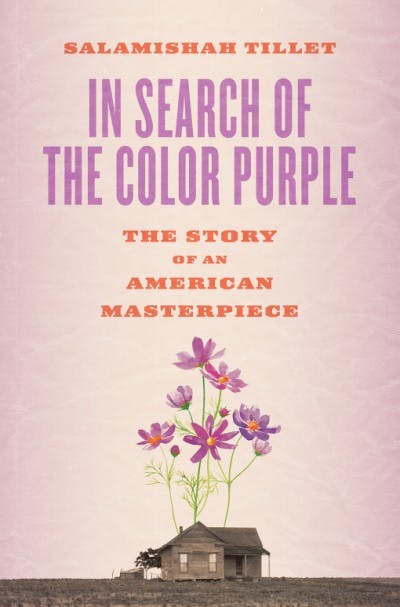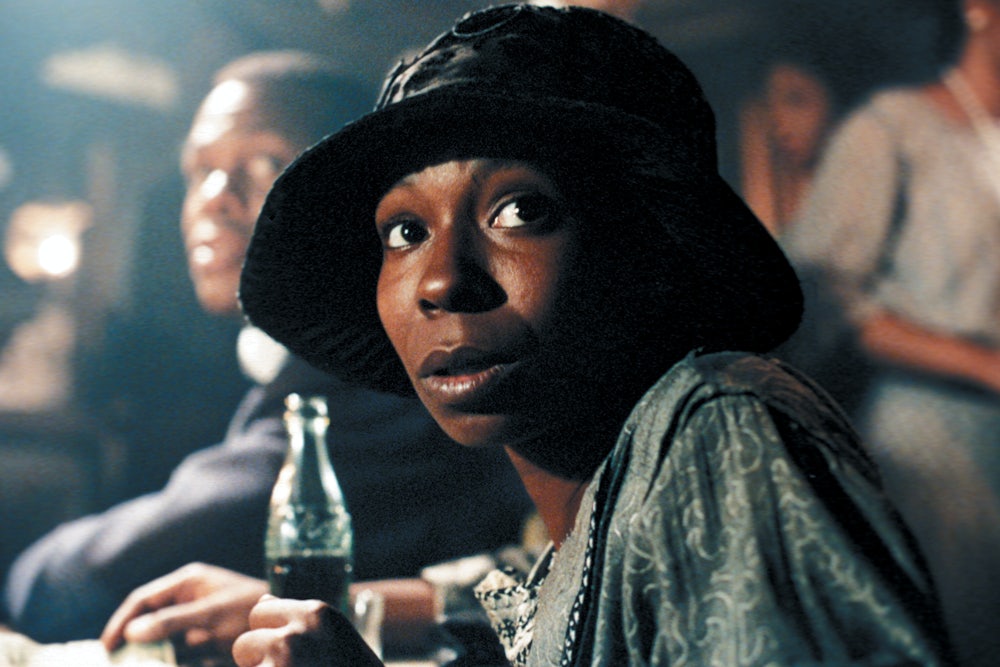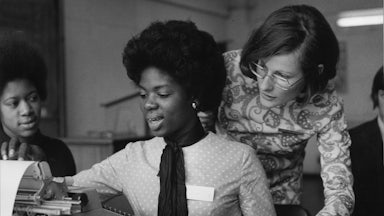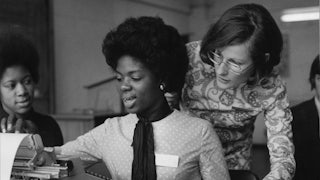During my sophomore year of college, my mom drove up to New York to take me to see The Color Purple on Broadway. We were not then and are not now a Broadway family: It remains the only musical I have ever seen in person. Still more, we bought merch! It all felt wildly out of character, but this was The Color Purple, the favorite movie of every Black woman in my family—how could we not at least take home a branded refrigerator magnet? At one point in the show, the characters Shug and Celie, whose relationship broke ground in terms of Black lesbian representation in literature (and later on screen), were being affectionate with one another. A woman in the row ahead of us started sucking her teeth in disgust and otherwise making her sentiments loudly known. It was deeply uncomfortable, and it seemed like she was going to go on forever until, suddenly, my mother piped up and said, for everyone to hear, “This is what happens when people don’t read the book.”

The film version of The Color Purple (1985) largely excised the lesbian relationship at the center of Alice Walker’s Pulitzer prize–winning novel. Steven Spielberg, who directed the film (with Quincy Jones producing), explained the choice to have the two women kiss just once, and briefly. Had there been more, he said, “there would have just been too much on that one taboo.” Too much of what, and from whom? During production, the film was the subject of coordinated attacks, largely from Black male critics and certain community leaders who thought the novel—which explored unsparingly the subjects of incest, childhood rape, and domestic violence within the context of a single family in the rural South of the 1920s—furthered an image of Black men as violent and sexually aggressive. While the movie was still in production, an organization called the Coalition Against Black Male Exploitation sent out a bulletin claiming the relationship between Shug and Celie was an attack on Black male sexuality: “One must suspect this affectionate feminine display will be contrasted with an unfulfilling exchange between a black man and a black woman.”
In her new book, In Search of The Color Purple, the feminist scholar and writer Salamishah Tillet, writes that while “Jones and Spielberg insisted that these threats bore no impact on the movie itself,” there is little doubt that it sank the movie’s Oscar chances. The film, nominated for 11 Academy Awards, went home empty-handed, losing the top prize to Sydney Pollack’s Out of Africa (1985), a film based on the Isak Dinesen novel that, Tillet says, “basked in colonial fantasies of African primitivism and black inferiority.” Tillet, who is a professor of African-American studies and creative writing at Rutgers University and a contributing critic at The New York Times, offers up a history of The Color Purple, from novel to film to Broadway musical, with an emphasis on how sexism within the Black community—and the white establishment’s preference to frame racial injustice in terms of concerns facing Black men—stood between The Color Purple and recognition as “an American masterpiece.”
The Color Purple (1982) is an epistolary novel set in the interwar period of the early twentieth century. It begins with a 14-year-old girl named Celie writing to God about the sexual abuse she is suffering at the hands of the man she believes to be her father. He impregnates her twice, and takes the children away each time (for a while, she thinks he has killed them). Eventually, she is married off to a man she calls Mr.______, who abuses her emotionally, sexually, and physically. The only person in the world she feels loved by, her sister Nettie, runs off for fear of being raped by their father now that Celie is out of the home. For Tillet, Walker’s novel strikes a personal chord. A rape survivor herself, in 1997, she and her sister Scheherazade created “A Long Walk Home: Story of a Rape Survivor,” a multimedia project that documented Tillet’s process of healing. Tillet, who read The Color Purple the year before starting college, credits the novel with helping her come forward: “I broke my silence because of The Color Purple,” she writes.
In the chapter on the Broadway adaptation, Tillet interviews Oprah Winfrey (who was a co-producer on the musical, along with Harvey Weinstein and others), who played Sofia, Celie’s brash and outspoken daughter-in-law who meets a tragic fate, in the film. Winfrey, too, is a survivor: As a child, she was repeatedly raped by family members and older men, at one point falling pregnant with her uncle’s child. Winfrey tells Tillet how much The Color Purple meant for her, how it helped her feel less alone: “I opened the page and saw Dear God, fourteen years old, what’s happening to me? Being a girl who was fourteen years old who had a baby, I was like, ‘There’s another human being with my story.’”
It was that very willingness to call out sexual violence within the Black community that made The Color Purple, the book, but particularly the film, the target of vitriol. When Gloria Steinem’s Ms. magazine put Walker on the cover in advance of the novel’s publication, the Black writer and satirist Ishmael Reed claimed Walker was Steinem’s “pawn.” In an interview for an Australian newspaper, from which Tillet quotes, Reed says, “There’s the kamikaze feminist and the Gloria Steinem Axis, and the Black Feminist Auxiliary. I think Alice Walker is part of this group, which characterizes Black men as rapists.” Steinem told Tillet, “The idea that anyone could ever control Alice. It’s so ridiculous, it’s like controlling the ocean!” The Hollywood–Beverly Hills chapter of the NAACP picketed the film, holding signs that read, “Are White Producers Trying to Destroy Black Men?” In 1986, the journalist Tony Brown devoted an entire episode of his show, a popular independent Black news program called Tony Brown’s Journal, to the controversy and dubbed it “Purple Rage.” He later went on The Phil Donahue Show, where he called the film “the most racist depiction of black men since The Birth of a Nation.” The director Spike Lee, then promoting his film She’s Gotta Have It, told interviewers, “The difference between this film and The Color Purple is that even though there are some dog Black men in this film, you can tell there is a difference. The film was not done with hate.”
For Tillet, the uproar surrounding The Color Purple is just one instance of a perennial problem for Black women doing creative and political work at the intersection of gender and racial politics. “The controversy also took such a firm hold,” she says, “because it drew upon a stereotype that at the time was well-known among African Americans but far less familiar to white people: the black woman as race traitor.” Tillet sees echoes of this in critiques of the #MeToo movement, particularly in responses to allegations involving high-profile Black men like the rapper R. Kelly and the hip-hop and fashion mogul Russell Simmons.
Reading Tillet, I was reminded of an essay by Jemele Hill, “R. Kelly and the Cost of Black Protectionism.” Written in response to Surviving R. Kelly, the Lifetime documentary that featured firsthand testimony from his accusers and enablers, Hill highlighted the way high-profile Black men (and their lawyers) have compared the women accusing them of sexual assault to lynch mobs. Following the premiere of the documentary and the subsequent proliferation of the hashtag #MuteRKelly, Kelly’s legal team released a statement promising, “Since America was born, black men and women have been lynched for having sex or for being accused of it. We will vigorously resist this attempted public lynching of a black man who has made extraordinary contributions to our culture.” Similar language was invoked by Clarence Thomas in his statement to Congress during the Anita Hill hearing, which he called a “high-tech lynching,” and by Bill Cosby’s wife when the rape allegations against Cosby first came to light. For Hill, the use of the word lynching is meant to signal to Black women and girls that racial oppression must remain their primary concern, and as a result many refuse to come forward with their allegations against Black men, “because they don’t want to become another vehicle that contributes to their destruction.”
Likewise, Tillet powerfully puts forward the Color Purple controversy as an example of how Black women have been asked to silence their own pain to supposedly serve the greater cause of racial uplift. Threaded throughout these attacks on The Color Purple is the idea that the danger of reinforcing stereotypes about Black male sexuality is too great to allow room for Black women to have justice.
Sadly though, I found Tillet ultimately guilty of a similar kind of thinking when it came time to address Walker’s well-documented antisemitism. In 2018, in a piece for The New York Times, Walker recommended And the Truth Shall Set You Free by the antisemitic conspiracy theorist David Icke. Walker called the book, in which Icke gives credence to Holocaust deniers and promulgates conspiracies about Jewish global domination, “a curious person’s dream come true.” Shortly afterward, an earlier poem written by Walker surfaced in which she repeats a willfully misinterpreted section of the Talmud that antisemites like to claim sanctions marriage with 3-year-old girls (it does not). The revelation of Walker’s antisemitism comes up just once in Tillet’s book, when she remarks on Walker’s resilience in the face of attacks:
Each embroilment, starting with the early criticism that she had colluded with Gloria Steinem and Steven Spielberg in violently stereotyping black men in The Color Purple, to the abuse she endured for her indictment of female genital mutilation in Africa in Possessing the Secret of Joy … to the more recent accusations of anti-semitism as a result of her naming British conspiracy theorist David Icke’s And the Truth Shall Set You Free as an entry for “By the Book,” a weekly feature in The New York Times Book Review, all stereotyped her as a black woman filled with hate and consumed by anger.
I gasped when I read this. Rhetorically, Tillet’s words here have the effect of situating those offended by Walker’s antisemitism alongside the misogynist male critics who lampooned the film, and implies that those who call out Walker’s behavior are contributing to stereotypes about Black women. This is so disappointing from Tillet, who has just spent an entire book forcefully explaining how the fear of reinforcing racial stereotypes resulted in the silencing of an entire community. Tillet goes on to describe a December 2018 article by Nylah Burton, a Black Jewish writer who wrote about the controversy surrounding Walker and Icke, drawing largely conciliatory quotes from Burton’s otherwise quite critical piece, in which Burton laments that an author like Walker “could put the burden of her trauma onto us—black Jewish women.” The result is an unfortunate conclusion to an otherwise powerfully persuasive and emotionally raw book about the indignities Black women have faced just trying to tell their stories, on the page and in life.
What comes through most in Tillet’s book is that the reception of The Color Purple in its various iterations overshadowed the work itself, as so many of the prominent critical voices in Black American letters have been forced to turn their attention to picket signs, boycotts, Oscar campaigns, and talk shows, rather than the novel itself. The fear of how it could be used to stereotype Black men has resulted in it being analyzed as a proxy war first, a work of art second. Unlike Tillet, however, I am not convinced that the alternative would produce a chorus of people claiming The Color Purple a “masterpiece.” For my part, I find it aesthetically awkward, and many of the relationships, particularly the friendships between women, still feel to me like they were shoehorned into second-wave feminist narratives about solidarity. That such a conversation—about the art itself—feels marginal to The Color Purple and its place within literary history is just another frustrating example of how little room the world gives Black women not just to succeed but also to fail—artistically and morally.








